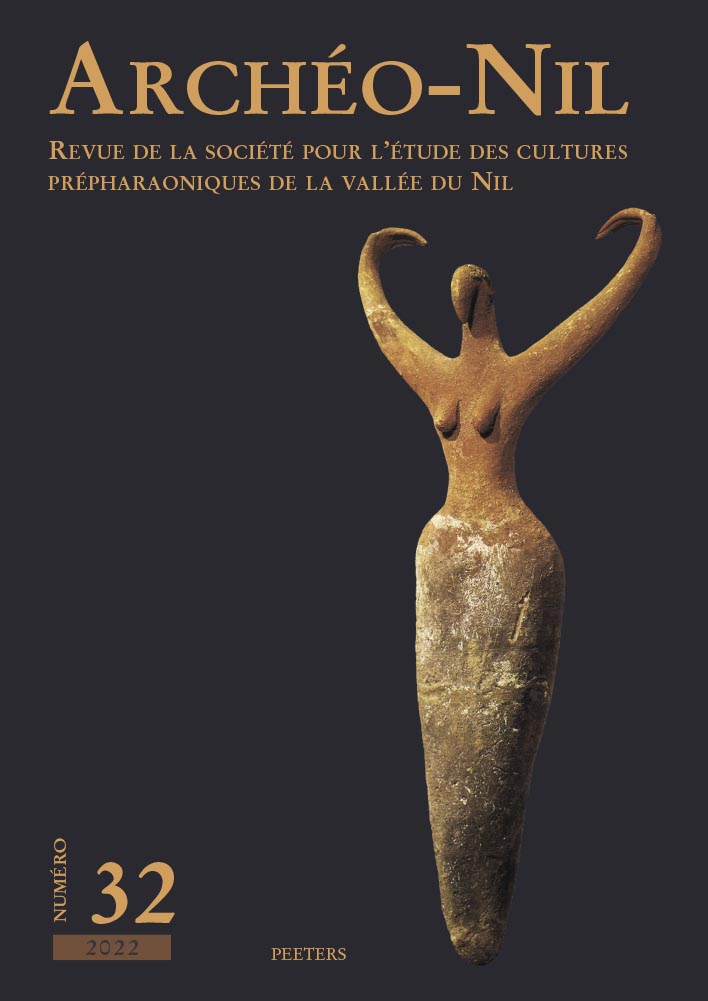 previous article in this issue previous article in this issue | next article in this issue  |

Preview first page |
Document Details : Title: Technical Choices and Processes of Stone Vessel Manufacture under the Reign of King Den Subtitle: Evidence from the Cemetery M at Abu Rawash Author(s): TAKENOUCHI, Keita Journal: Archéo-Nil Volume: 31 Date: 2021 Pages: 135-157 DOI: 10.2143/ANI.31.0.3291289 Abstract : Stone vessels were produced on a large scale during the Early Dynastic Period. The production of stone vessels in this period is a typical example of the development of attached specialists that occurred parallel to the emergence of the central government and administration. However, we are not thoroughly familiar with the specifics of the manufacturing techniques and system that supported this large-scale production in Early Dynastic society. This paper reconstructs the detailed manufacturing techniques and processes of the cylindrical jars and the open forms through the observation and analysis of the unpublished materials from the Cemetery M (excavated by Montet) at Abu Rawash. This research has found that travertine bowls were probably shaped by irregular and less precise polishing than mudstone. Additionally, the deeper bowls were found to have a intensive use of 'figure-of-eight' shaped reamers. Craftsmen also selected techniques, processes, and tools according to vessel shape and size in addition to the hardness and nature of the stone. The detailed manufacturing process of the cylindrical jars is also reconstructed. These cylindrical jars can be classified into two categories: high-quality and low-quality jars. The low-quality and small-sized jars were manufactured by a more intensive use of 'figure-of-eight' shaped reamer. A comparison with quantitative data from other cemeteries at Abu Rawash and other Early Dynastic sites indicates that the low-quality and the small jars were probably supplied to Abu Rawash as 'commoditized products' during the 2nd Dynasty. Finally, the article discusses the increased use of rotational reaming techniques with a 'figure-of- eight' shaped reamer in the manufacture of both cylindrical jars and bowls during the 2nd Dynasty. Les vases en pierre étaient fabriqués à grande échelle durant la période protodynastique. Ce type de production est un exemple caractéristique de l’émergence d’artisans spécialisés rattachés au gouvernement central naissant et son administration. Toutefois, les spécificités des techniques de fabrication et de ce système de production à grande échelle nous sont encore mal connus. Cet article s’intéresse à la reconstitution des techniques et processus de fabrication des jarres cylindriques et des vases en pierre de formes ouvertes à partir de l’observation et de l’analyse des exemplaires inédits provenant du Cimetière M d’Abou Rawach (fouilles de Pierre Montet). Les bols en travertin ont probablement été façonnés par un polissage irrégulier et moins soigné que les récipients en schiste. En outre, plus les bols étaient profonds, plus l’utilisation de mèches en forme de huit était intensive. Les artisans ont également sélectionné les techniques, les procédés et les outils en fonction de la forme et de la taille des récipients, et pas seulement de la dureté et de la nature de la pierre. Le processus de fabrication détaillé des jarres cylindriques a pu aussi être reconstitué. Elles peuvent être classées en deux catégories: bonne et mauvaise qualité. Les jarres de mauvaise qualité et de petite taille ont été fabriquées en utilisant la mèche en forme de huit de manière plus intensive. La comparaison avec les données quantitatives provenant de cimetières d’Abou Rawach et d’autres sites protodynastiques montre que ces petites jarres étaient produites en masse lors de la IIe dynastie, avec une utilisation accrue de la mèche en forme de huit pour la fabrication des jarres cylindriques et des bols au cours de cette période. |
|


